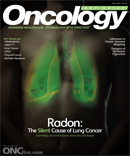Cancer Risk: Role of Environmental and Lifestyle Factors
While family history and lifestyle factors affect cancer risk, environmental factors also play a considerable role. You will no doubt recall the movie Erin Brockovich, which recounted the story of a law firm file clerk uncovering the dumping of hexavalent chromium, also called chromium 6, into the groundwater supply of Hinkley, a small town in southern California, by Pacific Gas & Electric.
While family history and lifestyle factors affect cancer risk, environmental factors also play a considerable role. You will no doubt recall the movie Erin Brockovich, which recounted the story of a law firm file clerk uncovering the dumping of hexavalent chromium, also called chromium 6, into the groundwater supply of Hinkley, a small town in southern California, by Pacific Gas & Electric. This finding and subsequent lawsuit led to one of the largest toxic tort injury settlements in US history, with $333 million in settlements awarded to approximately 600 Hinkley residents suffering from ailments such as breast cancer, Hodgkin lymphoma, lung cancer, brain-stem cancer, gastrointestinal cancer, kidney and ovarian tumors, and a host of other maladies as a result of being exposed to chromium 6. While similar cases have surfaced throughout the United States, and stories of chemicals being leached into drinking water by corporate entities may receive considerable attention by the media, there are naturally occurring environmental risk factors for cancer, such as radon, that receive comparably little attention but affect far more households.
The ill health effects of radon have long been observed in miners, but it was not known to be a health risk in the general population until the 1980s. Radon is now known to be the second leading cause of lung cancer, and it may contribute to the development of other cancers as well, yet the only time this environmental risk factor may be brought to anyone’s attention is during a real estate transaction. January is National Radon Action Month, as designated by the US Environmental Protection Agency, and our cover story, “The Invisible Killer in Your Home: Understanding Radon, Testing, and Mitigation”, provides an overview of radon, testing methods, and locating a mitigation professional, while outlining some online resources that can help keep you, your family, and your patients informed and safeguarded from this environmental health hazard.
Our second feature story, “Mapping the Cancer Genome”, reviews some of the findings that cancer genome sequencing has yielded, including how environmental and lifestyle factors can increase cancer risk. Recently, researchers from the Wellcome Trust Sanger Institute in Cambridge reported the results of their study published in Nature, which compared the genetic sequence of small cell lung cancer cells and melanoma cells with normal cells taken from the same individuals. Through this analysis, the researchers were able to identify thousands of mutations in the cancer cells, with almost all mutations in the small cell lung cancer and melanoma cells being traced back to smoking and ultraviolet exposure, respectively. The researchers estimate that a typical smoker may acquire one mutation for every pack of cigarettes smoked, and one may surmise that exposure to other environmental toxins, such as radon, could lead to additional mutations, as research has shown that lung cancer risk from radon is especially high in smokers. As more cancer cells are sequenced, which is being made possible by the dramatic drop in gene mapping costs, the effects of various carcinogens and the role of genetic factors will be better understood, which will also lead to more effective, personalized treatments.
In our From the Editor column, Dr Markman discusses electronic cigarettes, which have become increasingly popular, with some individuals using them as an alternative to traditional cigarettes because they are perceived to be healthier. As Dr Markman points out, however, assessment of these cigarettes has shown that they may contain other known carcinogens, as this industry is largely unregulated. Further, because electronic cigarettes are relatively new, their ill health effects are not yet known; thus, patients expressing interest in using electronic cigarettes should be warned of their potential dangers.
We hope you enjoy this issue of Oncology Net Guide and would love to know what you think of it, or if you have any topics you would like to see covered in an upcoming issue. You can send an e-mail to the editor, Christina Loguidice, at cloguidice@onclive.com.
Thanks for reading!




